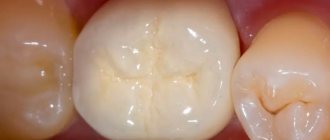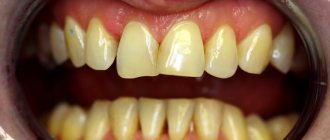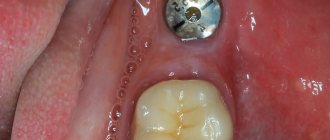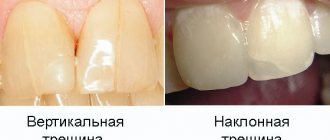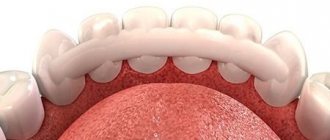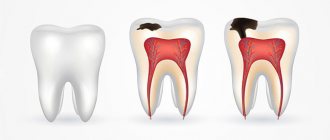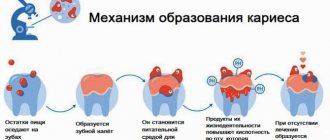Causes of dental defects
Lengthening or shortening of one of the incisors is usually a congenital anomaly. This feature of dentition development is associated with genetic factors. Experts also include the following as possible causes of the problem:
- periodontitis,
- malocclusion,
- presence of supernumerary teeth,
- abnormal shape of the alveolar process,
- disruption of the process of resorption of the roots of baby teeth.
Changes in the length of the central incisor can also be a consequence of jaw trauma. If a tooth is mechanically damaged, its lower part may chip. Because of this, the appearance of the smile deteriorates, discomfort occurs when chewing, and the risk of developing various diseases increases.
Why does thorotoanomaly occur?
Most often, the tooth is forced to take a pathological position due to lack of space in the jawbone due to macrodentia (large teeth in relation to the bone) or an excessively narrow jaw. In this case, it tends to turn around so as to take up as little space as possible, and the minimum will be achieved when turning at an angle of 45°. But pathology arises not only due to the primary lack of free space.
- The crown can rotate in the socket due to constant pressure exerted on it from the side or below, either by a supernumerary tooth, or by complete “neighbors” that erupt not entirely physiologically - for example, with a delay.
- Quite often, erupting permanent teeth unfold due to the persistence of the milk teeth that precede them. If during the period when baby teeth fall out, the “old” one is in no hurry to fall out, then the “new” molar will have to bypass the obstacle, deviating to the side or turning around the vertical. Pathology can be avoided by timely removal of worn-out milk teeth.
- Sometimes the cause of non-physiological tooth eruption is a dental follicle that is incorrectly formed during pregnancy or in early infancy.
- Often a permanent tooth rotates as a result of a mechanical injury received by a child at the stage of changing the primary bite to a permanent one.
Possible consequences
Dental defects must be corrected in a timely manner. On chipped teeth, the enamel becomes thinner, so they quickly turn yellow and soon acquire a brown tint. In addition, the cracks are filled with plaque, which mineralizes and becomes a favorable environment for the growth of bacteria. Because of this, the risk of developing caries, pulpitis, gingivitis and periodontitis increases.
Congenital dental anomalies also lead to various problems. Let's list the main ones:
- speech dysfunction,
- formation of mouth breathing,
- uneven distribution of chewing load,
- development of gastrointestinal tract diseases.
To avoid serious health problems and maintain the integrity of the dentition, it is necessary to correct uneven incisors.
How does crowded teeth occur?
The development of clinical symptoms is due to the fact that there is not enough space on the jaw for the teeth to take the correct position. This may be due to its insufficient size, too large teeth, their excessive number, or overcompleteness. In adult patients, the development of anomalies is most often caused by pressure on the dentition of the erupting eights, which affect neighboring teeth, leading to their displacement and crowding.
Stages and symptoms of the disease
A predisposition to the development of anomalies can be identified already in early childhood by contacting an orthodontist. During the examination, the specialist will find that there is no gap between the child’s baby teeth. This sign indicates that, with a high degree of probability, there will be no room for erupting teeth in the permanent dentition. As they appear, the problem will only get worse. Timely identification of negative factors in children would help normalize the situation even at the stage of primary occlusion. However, specialists very often encounter the fact that even with congenital prerequisites, patients turn to a specialist only during the period when the permanent dentition is fully formed and clinical signs are evident.
The anomaly is characterized by varying degrees of severity, which determines clinical symptoms and possible complications. The degree of development of pathological signs also affects treatment tactics, as well as prognosis. Depending on the symptoms of dental crowding , there are 3 degrees of damage.
- A mild degree of anomaly is characterized by minimal changes in the position of 1-2 teeth in the dentition. For them to take the correct position, only 2-3 mm are missing. The problem does not apply to the remaining teeth; they occupy a clearly defined place;
- With a moderate degree of anomaly, the problem also affects only single teeth. They are rotated around their axis, shifted relative to the dentition, and can be tilted. Their displacement corresponds to 5-6 mm;
- In the case of a severe anomaly, its manifestations are clearly visible to others. The aesthetics of the smile are compromised due to deformation of the dentition ; some teeth are pushed out of the dentition. The shape of the arc appears to be changed.
The main disadvantage caused by the anomaly is that crowding of teeth leads to deterioration in the aesthetics of the dentition. This is especially noticeable with severe damage. However, this problem is not the only one.
With this position of the teeth, the possibilities for high-quality cleaning procedures are noticeably deteriorated. The prerequisites will be created for the formation of plaque, which will affect the change in the shade of the enamel, manifest as tartar deposits, and the presence of bad breath. Lack of proper hygiene will lead to the development of other diseases of the dental system and the appearance of additional symptoms. In addition, incorrect position of the teeth can contribute to injury to the mucous membranes. Symptoms will be supplemented by such manifestations as bleeding, inflammatory or erosive process.
Possible complications if left untreated
Crowding of teeth is dangerous not only due to aesthetic problems. Lack of proper care contributes to the deposition of plaque and, as a result, the development of caries and various periodontal diseases. At the same time, the pathological process often begins in hard-to-reach places, interdental spaces, which complicates its diagnosis by visual methods. Such patients turn to specialists already in the presence of pronounced signs of caries or its complications. Late treatment is dangerous because during treatment it is not always possible to save the tooth.
Insufficient oral hygiene and plaque deposits contribute to the activity of pathogenic microorganisms in the oral cavity with the development of gingivitis, periodontitis and periodontal disease. If treatment is delayed or the measures taken are incorrect, the consequences of violations may be increased mobility of teeth, and even their loss.
Is treatment necessary?
The choice of treatment tactics for crowded teeth depends on the degree of development of the anomaly. However, experts are unanimous in the opinion that correction is necessary even with minimal aesthetic disturbances that are hardly noticeable during articulation. If you ignore orthodontic treatment, there is a risk of developing dental pathology due to insufficient preventive measures.
The consequence of the caries process and tooth loss can be disruption of the functioning of the temporomandibular joint, difficulty chewing food and the development of gastrointestinal disorders. Improper closure of the dentition is one of the possible causes of headaches and insomnia. Due to the unevenness of the load, such a predisposing factor will contribute to the rapid wear of the teeth that are most involved in chewing movements.
Treatment methods for crowded teeth: Daimon Q braces, aligners, plates, separation and extraction
The choice of the optimal correction technique is determined based on the results of the diagnostics performed, which makes it possible to clarify the volume and condition of the bone tissue, the position of each tooth, and its parameters. The most popular are orthopantomogram, teleroentgenogram and computed tomography. Based on the results obtained, a treatment plan is drawn up.
Treatment of crowded teeth should begin as early as possible, especially if the cause of the presence of pathological signs is insufficient development of the jaw. An anomaly caused by jaw characteristics is more difficult to correct, especially when contacting specialists late, when the bones are fully formed. Orthodontic devices such as removable plates, dental trainers , activators, palatal expanders will be effective only in children, since their jaw bones are still in the developmental stage and are better amenable to correction.
By the age of 12, wisdom teeth begin to form: their rudiments can be diagnosed through x-ray studies. The further action plan is based on this factor. If it becomes clear that there is not enough space for the development of eights, a decision will be made to remove them in an unerupted state.
Moreover, in adult patients, not only eights are removed. The need for tooth extraction is also due to factors such as supernumerary and macrodentia. In addition to eights, it is often necessary to remove fours or fives. By removing 2 teeth, you will be able to free up about 6 mm of additional space. This will create the prerequisites for straightening the dental arch. To increase the effectiveness of the result and force the teeth to move in the desired direction, braces or aligners are subsequently used in adult patients.
In addition to the use of orthodontic systems, other treatment options are used. One of them is separation, that is, grinding the contact surfaces of permanent teeth. During such an event, specialists use a bur to remove about 0.5 mm of the contact surface of the tooth. Having received additional space, the prerequisites for teeth straightening appear. As in every orthodontic technique, in this case the professional skills of the specialist are extremely important. When excessive amounts of tooth tissue are sanded off, it becomes sensitive to the effects of negative factors. This is accompanied by unpleasant sensations, and too thin a layer of enamel increases the prerequisites for the development of the carious process.
Treatment of crowded teeth in adults
In adults, treating crowded teeth in the lower jaw is a more common procedure than correcting the same anomaly in the upper jaw. The choice of treatment tactics in this case is made depending on the severity of clinical signs, as well as the factors that contributed to the development of the anomaly. Since most often the problem lies in the dystopic position of the eights, which has a negative impact on other teeth in the row, their removal is the initial stage of orthodontic correction. With macrodentia, extraction may also affect other teeth. Some improvement in the situation is also achieved by tissue separation.
Minor imperfections can be hidden by installing ceramic onlays and veneers. To ensure a strong fixation, in this case it will be necessary to slightly grind down the front surface of the tooth. This procedure falls under the competence of an orthopedic dentist. However, in this case we are not talking about correcting an orthodontic disorder, but only about leveling out aesthetic deficiencies.
In adults, dental crowding in the lower jaw is most often treated with braces. The same approach is taken as a basis for the development of anomalies in the upper jaw. Braces systems are non-removable orthodontic devices that are installed for the entire period of corrective measures. The main element in them are clasps that are fixed to the tooth surface, and a durable metal arch. It is its elasticity and the desire to take its original position that contribute to the movement of teeth. Fastening the arch to the locks is ensured using ligatures, rubber bands and wire, or by means of a special device that fixes the clips mounted in the lock. Such technical features determine some features of the functioning of the devices.
Treatment methods with and without braces
If teeth are crowded, treatment without braces is also possible in adults. An alternative is to use aligners. These removable mouthguards are made in strict accordance with individual parameters. By firmly installing on the dentition and causing pressure on it, they contribute to the displacement of teeth in a given direction. The patient wears the system for two weeks. After that, he changes it to the next model, which is slightly different in its physical dimensions. This treatment differs from braces in that it remains invisible to others.
High-tech production of aligners allows you to create ultra-thin and completely transparent models. They are invisible on the teeth, so the correction process is highly aesthetic. The ability to remove aligners as needed and ease of care make it possible to completely prevent damage to tooth enamel and make treatment safe.
Braces, aligners and plates
Treatment with braces has been carried out for half a century. Over the years, the technical characteristics of the locks have changed significantly; models have appeared in which there are no ligatures that secure the arch. Significant changes affected the possible design of braces and the material used to make clasps.
At the same time, the demand for aligners for teeth straightening is due to their high efficiency, almost comparable to braces, and excellent aesthetic properties. Patients who are interested in the treatment being invisible to others and who have the financial means to carry it out with the help of aligners, choose such systems.
As for the expansion plates, their action is aimed at gradually leveling the jaw row through systematic pressure on it. The functioning of this design is ensured by the elasticity of the plate, fastening screws and a spring, and fixation on the teeth is carried out using hooks. Despite the fact that the effectiveness of the systems is due to individual manufacturing, their use is more relevant in adolescents until the jaw bone is fully formed.
Crowding and wisdom teeth
Wisdom teeth are the last to appear, by the age of 20-25, when the bone tissue is formed and has reached its maximum density, so their eruption is often difficult. They can rest against the bone or adjacent teeth, putting pressure on them and displacing them. There is often no place left for them due to evolutionary processes.
The combination of all these factors leads to the fact that the eruption of wisdom teeth is accompanied by pericoronitis, up to abscess and phlegmon, resorption of the root of the adjacent tooth, as well as crowding of teeth. You can identify the problem in advance by contacting a specialist and carrying out appropriate diagnostics. Already on the basis of a panoramic image, it will be possible to determine all the negative factors associated with the eruption of figure eights, and prescribe additional studies and corrective measures.
When should you see a doctor?
Dentist help is necessary if one of the incisors is in a high or low position. In children, this defect can disappear without any intervention when replacing milk teeth with molars. If different lengths of the front teeth persist despite a fully formed bite, you should consult a doctor.
You should also contact a specialist:
- when the enamel darkens,
- increased sensitivity of teeth,
- acute toothache,
- cutter mobility,
- formation of a sharp cutting edge.
The dentist will conduct an examination, determine the cause of the problem and help solve the problem.
What it is?
The anomaly is expressed in the uneven growth of individual units in relation to the entire dentition.
Changes in size can be observed in fully formed single teeth or an entire group. But the second option occurs in rare cases.
The high position of the teeth is called supraocclusion, the low position is called infraocclusion.
How is it determined?
The main symptoms of the anomaly are the discrepancy between the height of the crown part of the tooth and the norm. Supraocclusion is identified by the excessive length of the tooth extending beyond the occlusal plane. In this case, the shape and width of the coronal part does not differ from normal bone organs.
The high position is often accompanied by lengthening of the arches in the dentoalveolar plane and displacement of the teeth in the vertical direction. One of the signs of pathology is an open bite, the degree of which will depend on the height of the abnormal unit.
Infraocclusion is determined by the insufficient height of the organ, which does not reach the occlusal line. In this case, the closure with the antagonist teeth is partially impaired or completely absent.
The x-ray shows underdevelopment of the alveolar process. According to its clinical picture, infraocclusion is similar to semi-retention.
Infraocclusion of several adjacent teeth, in most cases, is combined with a deep bite.
Meaning of symptoms
These symptoms not only determine the degree of the anomaly, but also distinguish it from diseases with similar symptoms.
Supraocclusion must be differentiated from the Popov phenomenon. A high position is characterized by maintaining normal shape and size. With the Popov phenomenon, the coronal part significantly exceeds the anatomical standard dimensions. In this case, it is observed to move out of the alveolar socket due to bone tissue deposits at the bottom of the socket and excessive development of the alveolar process.
When diagnosing infraocclusion, it should be distinguished from incomplete retention. The main difference will be the underdevelopment of the alveolar part of the tooth with a low location.
Otherwise, it will not differ from nearby normal bone organs.
Methods for correcting front teeth of different lengths
Discrepancy in the coronal height of the central incisors can be corrected in several ways.
- Filling. Photopolymer restoration is the most affordable method of restoring the optimal length of teeth. Using composite material, you can build up the missing part of the crown.
- Wearing braces. Orthodontic treatment allows you to eliminate various defects in the dentition, including shortening and lengthening of one of the incisors.
- Installation of veneers. Ceramic or porcelain onlays replace the outer layer of teeth and provide the desired length. You can choose plates of a natural shade or snow-white.
When choosing an appropriate correction method, it is necessary to take into account the degree of deviation of the tooth height from the norm and the characteristics of the bite.
Teeth filing
If the difference in the length of the teeth is too noticeable and prominent, you can resort to filing the teeth. This procedure is performed for various deficiencies in the dentition: if the edges of the teeth are too sharp and scratch the cheeks and gums, or if the shape of the teeth is too triangular, as well as before installing crowns or veneers and before starting orthodontic treatment in some situations, the teeth are filed down to make room for further shift.
When filing (grinding) teeth, a permissible layer of enamel is removed. However, during the process, excessive sensitivity of the teeth may occur - this defect is corrected by several procedures for remineralization and fluoridation of the enamel
.
Elimination methods
Methods for correcting malposition will depend on the degree of deviation in tooth height. Correction of supraocclusion with a slight deviation in height is carried out by grinding the surface of the cutting and chewing parts.
A slight deviation in height during infraocclusion can be corrected with crowns or ceramic onlays.
In the case of a complex anomaly, they resort to hardware treatment, the options of which will depend on the age of the patient and the cause of the deviation.
The low position is corrected using devices that extend the teeth simultaneously with the alveolar ridge.
For this purpose, classic orthodontic plates are used, equipped with an elastic rod, screws, springs and other additional devices that enhance the effect of the device.
High position is corrected through the use of mouthguards, inclined plates and braces.
The treatment method will, first of all, be selected based on the patient’s age. So, for children with primary and mixed dentition, more gentle options are used than for correcting anomalies with a permanent dentition.
Let's find out what impacted teeth are and how the pathology is eliminated.
In this publication we will talk about the reasons for the development of awl-shaped teeth.
Follow the link https://orto-info.ru/zubocheliustnye-anomalii/zubov/polozheniya/tremyi.html to learn more about gaps between teeth.
In children
To correct the height of teeth in childhood, removable appliances are most often used. In case of low position of single teeth, such a device is an orthodontic plate made of plastic, with a built-in vestibular metal arch located at the level of the cutting part of the teeth.
The arm of the device is curved in such a way that it exerts constant pressure only on the problem area in the area of the alveolar process. In addition to the bow, the device has a ring that is fixed on the abnormal organ.
A special hook is soldered onto the ring, designed to fix the vestibular arch. While wearing the device, the arc is thrown with force over the hook, creating force in the vertical direction.
To treat supraocclusion in childhood, they resort to the method of rebuilding the alveolar process of the problem area, due to the influence of a plate with a bite pad or special plastic overlays.
In order to ensure constant pressure on the pads and platform, light-curing plastic is periodically applied to them, which is then ground to the required height.
Treatment of anomalies in the position of tooth height in mixed dentition takes from 2 months to 1.5 years, depending on the severity of the anomaly.
For information on correcting the shape and position of teeth in the anterior part of the lower jaw, see the video.
In adults
In adults, as well as in children, intermaxillary traction is used to eliminate infraocclusion. Only in this case, non-removable devices are used, equipped with a rubber rod and wire ligatures.
This device consists of four support rings, two of which are fixed on the upper jaw and two on the lower teeth. On each ring, hooks are soldered on the vestibular side, on which an elastic rod is fixed.
Due to its influence, dentoalveolar elongation occurs. To enhance the effect, special beams with notches are soldered to the rings in a horizontal position to secure a wire ligature or additional elastic traction.
To achieve the effect, it may take from 6 months to 2 years, after which this device can be used as a retention option. It must be worn for at least 2 hours a day with the most minimal tension.
To eliminate supraocclusion, a complex technique is used using braces and orthodontic aligners. Combined use will allow the formation of a new shape of the alveolar bed and the correct position of the tooth.
The combination of methods significantly shortens the treatment period, the average duration of which is 1 year.


